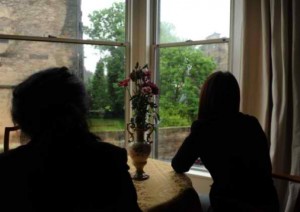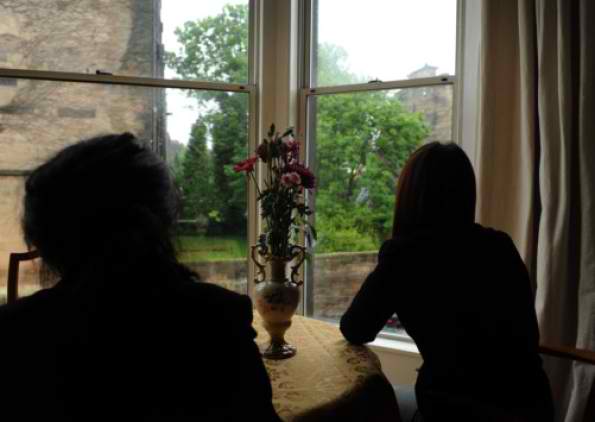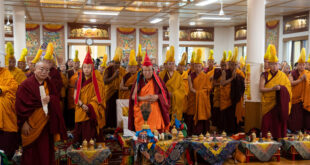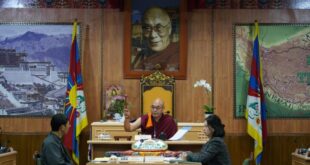By Sandra Dick (Scotman Online)
20 June 2012
TWO young women are sitting together in a comfortable Edinburgh flat, both dressed in smart clothes, both well-educated and softly spoken, their shining dark hair framing delicate and pretty features.
Bema Lhamo and Tsetan Dolgar have been talking calmly of a remarkable and dangerous journey, across snow-covered mountainous paths, through icy rivers and sodden fields. A journey which may have covered a distance of up to 1000 miles – the equivalent of 23 miles every day.

They have recalled, without the slightest quiver in their voices, the bitter and challenging conditions that confronted them, then just eight and seven years old, as they travelled on foot across the top of the world to a strange new land.
On the way, the terrified girls witnessed violence and pain, begged for food and sold possessions to stay alive. And they reeled in horror when they stumbled into a shelter only to find it scattered with rotting bodies.
They have told this harrowing story with deep sadness but also with a controlled calmness in their voices. Yet now, as they reach the end, they are crying, heads bowed, drops rolling down their cheeks to be quickly whipped away, embarrassed, by the back of a hand. They weep quietly, tears flowing in total silence.
Bema, 23, and 21-year-old Tsetan insist these tears are not for themselves. For it’s only as their thoughts turn to families left behind in Chinese-controlled Tibet, that the carefully contained composure finally slips.
“I was just six or seven,” Tsetan recalls. “The decision was taken to send me far away from my parents to get a better education. My parents are not able to contact me, they are scared they will lose their other children too.
“It is too difficult to get back to Tibet,” she continues. “Last year was the first time I was able to talk to my parents on the phone since I left them. The call was short, the line was cut off. But it was a chance to talk.”
Bema nods, for this is her story too. The girls met by chance on the same horrific journey that took them from Tibet to the northern Indian city of Dharamsala in the upper reaches of Kangra Valley, where exiled Tibetans have gathered for more than 50 years to learn and to teach and to pray for a time when they can return home.
Now in Edinburgh to study, the young women have decided to talk for the first time publicly of their incredible journey as the city prepares to greet His Holiness the 14th Dalai Lama. But even though years have passed since they last set foot in Tibet, their fears for their families’ safety there mean both have asked for their true identities to remain a secret.
“We don’t get good education in Tibet, our language is diminishing, we have to learn the Chinese language and the subject choices are not good,” explains Bema. “My parents are farmers, they realised how important Tibetan education is. I was eight years old.”
Barely able to comprehend what was happening, she recalls saying goodbye to her family and making the first stage of her dangerous journey to a nearby town with one of her brothers. A truck awaited to take her to Tibet’s capital, Lhasa, where she met Tsetan, who was part of a separate group of children making an identical journey.
From there the trip to Dharamsala – virtually in the footsteps of the Dalai Lama, left, years earlier as he fled Chinese rule – continued mostly on foot. A trek that covered nearly 1000 miles, across the Himalaya mountains, bound for the Indian border.
It is a cross-country journey that would challenge the most experienced trekker, equipped with the latest outdoor gear. Yet Bema and Tsetan had just their meagre possessions, some money sewn into the waistbands of their trousers and the help of a few elders.
“We had just a small amount of money to give to the people taking us on the journey,” recalls Bema. “I had some clothes, a spare pair of boots and some tsam-pa, food made from barley.”
They travelled at night – they can only guess at the miles they trudged in the darkness – and hid during the day, crossing treacherous ice and snow so thick that they eventually had to borrow yaks from villagers to help carry them. “It was treacherous,” recalls Bema. “You would climb a little then slide back down and have to climb up again. We stayed in a cave for three days while the others in the group went to beg for food. We had to sleep on the ice and when it melted we got wet, so we were wet all the time. We just wanted to go home.”
Bema threw her possessions away as the journey took its toll. Tsetan sold what she could to buy food.
The most horrifying point of their arduous six weeks journey was when they stumbled upon a derelict property, ideal for shelter even though it had no roof, only to find inside a group of dead bodies.
“We saw them with just their heads sticking out of the ground,” recalls Tsetan with a shiver. “We don’t know who they were or what happened.”
Bema nods: “We were worried then that we would not survive this journey too.”
They finally arrived at the border to be met by hostile guards who tied their hands behind their backs and threw the children into prison. As luck had it, a man familiar with the Tibetan plight came to their aid and released their group of around 20 – among them one child suffering from frostbite – to continue on their journey to a Nepali new arrivals house, safety and, eventually, boarding school.
Incredibly, they are far from the only children to make this nightmare journey. Around 30 per cent of Tibetan refugees in India are children, sent by parents on this dangerous journey in the hope they will learn Tibetan language, culture and heritage denied them at Chinese controlled schools.
Listening to Bema and Tsetan is Changchub Mermesel, 59, chairwoman of the Tibetan Community in Scotland. Tears rolls down her cheeks too – for she endured similar challenges in 1959 when her family joined the exodus sparked by the Chinese government’s occupation.
“I was six years old,” she says. “A lot of Tibetans came to India when China invaded. As a child I remember someone died every day from dysentery, lack of nutrition, the heat. Tibetans were not used to the heat and they did not have natural resistance to a lot of the diseases in India.
“There is a phrase used by the old people: ‘We left our country only to bury our bones in a foreign land’,” she adds, sadly.
Eventually the exiles moved to the dense upland forest area of the Kangra Valley and to Dharamsala, where the 14th Dalai Lama established the Tibetan exile administration. Today the area is known as Little Lhasa, a place where Tibetan refugees gather and children like Bema and Tsetan arrive to be schooled.
Their education there complete, the young women recently arrived in Edinburgh to begin a further education course and complete their professional training – made possible thanks to money from Tibetan supporters and sponsors.
Their great hope, however, is to eventually return to Tibet and to the families they have spent most of their lives parted from. Until then, their passports issued by the Indian government continue to brand them “Stateless”, a term which Changchub Mermesel finds hurtful. “It sounds like they have no home. But they do and it is in Tibet,” she says. “We are the lucky ones, we have survived and are in the position to do something positive for our people. There are many who do not make the journey.
“It is for these people that we cry, not for ourselves.”




